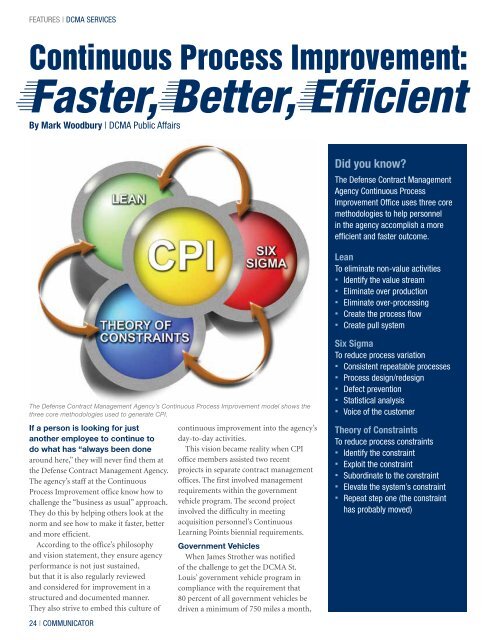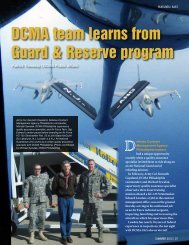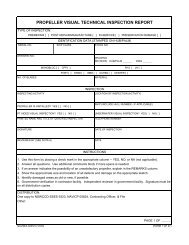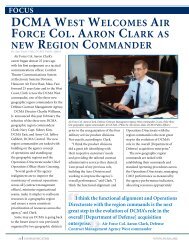Continuous Process Improvement: Faster, Better, Efficient - DCMA
Continuous Process Improvement: Faster, Better, Efficient - DCMA
Continuous Process Improvement: Faster, Better, Efficient - DCMA
You also want an ePaper? Increase the reach of your titles
YUMPU automatically turns print PDFs into web optimized ePapers that Google loves.
FEATURES | <strong>DCMA</strong> SERVICES<br />
<strong>Continuous</strong> <strong>Process</strong> <strong>Improvement</strong>:<br />
<strong>Faster</strong>, <strong>Better</strong>, <strong>Efficient</strong><br />
By Mark Woodbury | <strong>DCMA</strong> Public Affairs<br />
The Defense Contract Management Agency’s <strong>Continuous</strong> <strong>Process</strong> <strong>Improvement</strong> model shows the<br />
three core methodologies used to generate CPI.<br />
If a person is looking for just<br />
another employee to continue to<br />
do what has “always been done<br />
around here,” they will never find them at<br />
the Defense Contract Management Agency.<br />
The agency’s staff at the <strong>Continuous</strong><br />
<strong>Process</strong> <strong>Improvement</strong> office know how to<br />
challenge the “business as usual” approach.<br />
They do this by helping others look at the<br />
norm and see how to make it faster, better<br />
and more efficient.<br />
According to the office’s philosophy<br />
and vision statement, they ensure agency<br />
performance is not just sustained,<br />
but that it is also regularly reviewed<br />
and considered for improvement in a<br />
structured and documented manner.<br />
They also strive to embed this culture of<br />
24 | COMMUNICATOR<br />
continuous improvement into the agency’s<br />
day-to-day activities.<br />
This vision became reality when CPI<br />
office members assisted two recent<br />
projects in separate contract management<br />
offices. The first involved management<br />
requirements within the government<br />
vehicle program. The second project<br />
involved the difficulty in meeting<br />
acquisition personnel’s <strong>Continuous</strong><br />
Learning Points biennial requirements.<br />
Government Vehicles<br />
When James Strother was notified<br />
of the challenge to get the <strong>DCMA</strong> St.<br />
Louis’ government vehicle program in<br />
compliance with the requirement that<br />
80 percent of all government vehicles be<br />
driven a minimum of 750 miles a month,<br />
Did you know?<br />
The Defense Contract Management<br />
Agency <strong>Continuous</strong> <strong>Process</strong><br />
<strong>Improvement</strong> Office uses three core<br />
methodologies to help personnel<br />
in the agency accomplish a more<br />
efficient and faster outcome.<br />
Lean<br />
To eliminate non-value activities<br />
Identify the value stream<br />
Eliminate over production<br />
Eliminate over-processing<br />
Create the process flow<br />
Create pull system<br />
Six Sigma<br />
To reduce process variation<br />
Consistent repeatable processes<br />
<strong>Process</strong> design/redesign<br />
Defect prevention<br />
Statistical analysis<br />
Voice of the customer<br />
Theory of Constraints<br />
To reduce process constraints<br />
Identify the constraint<br />
Exploit the constraint<br />
Subordinate to the constraint<br />
Elevate the system’s constraint<br />
Repeat step one (the constraint<br />
has probably moved)
From left: Sharlee Lebrecque, Chris Knaggs and James Stamper make up the Defense Contract<br />
Management Agency’s <strong>Continuous</strong> <strong>Process</strong> <strong>Improvement</strong> office. The office trains personnel to use<br />
the Lean, Six Sigma and Theory of Constraints methodologies to better work processes throughout<br />
the agency.<br />
he immediately thought of getting help<br />
from the CPI office.<br />
“I was always interested in being part<br />
of, and seeing how, the Lean Six Sigma<br />
project process worked within the agency,”<br />
said Strother. “Naturally, this seemed to be<br />
a perfect opportunity to accomplish the<br />
requirement through the assistance of the<br />
LSS processes.”<br />
He reached out to the CPI office and<br />
explained the project’s goal. The team<br />
then asked questions to ensure the<br />
project’s validity. Once validated, Strother<br />
and his project team were assigned an<br />
LSS Black Belt, Chris Knaggs, to mentor<br />
the team through the various parts of<br />
the project.<br />
“Knaggs’ help was invaluable,” said<br />
Strother. “Whenever I had an issue, he<br />
was there to help. Without his help I may<br />
still be fighting with the LSS reporting<br />
program, ‘Power Steering.’”<br />
After discussing the current government<br />
vehicle tracking and scheduling system,<br />
the team determined that a better way<br />
to manage and track usage would be to<br />
implement Microsoft Outlook calendars<br />
for the vehicles. This change permitted<br />
both easier vehicle scheduling and usage<br />
tracking. At the same time, the team also<br />
determined to implement a quarterly<br />
usage and mileage meeting.<br />
While reviewing the quarterly numbers,<br />
it became clear there were simply too<br />
many vehicles at the location. Over a<br />
10-month period, never once were all<br />
nine vehicles at the location all in use on a<br />
single day. According to Strother, once this<br />
information was documented, everyone<br />
could see that too many government<br />
vehicles were at the location.<br />
Because of the steps implemented as a<br />
result of the team’s recommendations, the<br />
office has: seen an immediate decrease in<br />
operating costs, maintained full vehicle<br />
availability and gotten the remaining<br />
vehicles over or near the 750 mile<br />
monthly requirement.<br />
Although the project started as a review<br />
of <strong>DCMA</strong> St. Louis’ government vehicle<br />
usage, after the office shared the results<br />
to <strong>DCMA</strong> Chicago Army Col. Jose Baez<br />
and his deputy, Joe Vernon, they requested<br />
the team also take a look at their office’s<br />
government vehicle usage. After analyzing<br />
their usage, the team determined some of<br />
their vehicles should be turned back into<br />
the U.S. General Services Administration,<br />
while others could be moved to different<br />
locations. Strother said the initial review<br />
of the changes was positive, but a second<br />
review for the Chicago office is scheduled<br />
for March to ensure effective use.<br />
Knaggs said it is always exciting to see<br />
when a team’s efforts meet the intended<br />
need. However, it is even more exciting<br />
when a team’s results get attention from<br />
others and expanded across a particular<br />
FEATURES | <strong>DCMA</strong> SERVICES<br />
region and, even sometimes, throughout<br />
the entire agency.<br />
<strong>Continuous</strong> Learning Points<br />
James Callihan had the difficult<br />
task of assisting <strong>DCMA</strong> St. Petersburg<br />
acquisition personnel in meeting their<br />
80 continuous learning points every<br />
two years requirement. Callihan and his<br />
team came up with a program, using the<br />
CPI methods, to help the CMO progress<br />
toward 100 percent compliance.<br />
Callihan reached out to the CPI office<br />
and explained the goal of his team’s<br />
project. Once again, the CPI office then<br />
validated the project and assigned an<br />
LSS Master Black Belt, James Stamper,<br />
as the team’s mentor. Callihan said he<br />
appreciated Stamper’s mentorship during<br />
the project and welcomed his approach<br />
to helping the team stay pointed in “the<br />
right direction.”<br />
“I think true leadership encourages the<br />
mentee to research the answers by pointing<br />
them in the right direction. Mr. Stamper<br />
did just that,” said Callihan. “He answered<br />
my questions by rephrasing them and<br />
then pointing me in the right direction.<br />
He enabled me to continue the learning<br />
process outside of the classroom. He<br />
challenged me by forcing me to answer my<br />
own questions.”<br />
Callihan said another important lesson<br />
Stamper taught, that led to the team’s<br />
overall success, was that the best leaders<br />
are also the best facilitators. “A project is<br />
only as successful as the team, and I had a<br />
great one,” Callihan said. “I merely helped<br />
steer the team and keep everything on<br />
task, but the suggestions we made were<br />
generated by a collaborative effort.”<br />
Using the LSS process, the team<br />
identified any non-value added activity<br />
and process variations and developed real<br />
solutions to mitigate the issues.<br />
Did you know?<br />
The Defense Contract Management<br />
Agency has 20 certified black belts<br />
and 110 certified green belts.<br />
Information current as of Jan. 31<br />
SPRING 2011 | 25
FEATURES | <strong>DCMA</strong> SERVICES<br />
“If a contract management<br />
office does not have<br />
someone who has been<br />
through the <strong>Continuous</strong><br />
<strong>Process</strong> <strong>Improvement</strong><br />
office’s training, I would<br />
recommend the CMO take<br />
advantage of the training<br />
the office provides.”<br />
— James Callihan, Defense<br />
Contract Management Agency<br />
St. Petersburg<br />
The Defense Contract Management Agency’s <strong>Continuous</strong> <strong>Process</strong> <strong>Improvement</strong><br />
model shows the three core methodologies used to generate CPI.<br />
26 | COMMUNICATOR<br />
First, the team set up basic training<br />
for everyone at the office to explain the<br />
training requirements and what classes<br />
counted toward the requirements. The<br />
team then went through the electronic<br />
Individual Development Plan process<br />
to ensure personnel there had the<br />
requirement counting classes on their<br />
e-IDPs. Lastly, the team implemented<br />
routine progress checks with personnel<br />
who had the requirement to assist them<br />
with meeting it.<br />
Because of the team’s efforts, <strong>DCMA</strong><br />
St. Petersburg has seen an immediate<br />
improvement in its compliance rating.<br />
These simple ideas spread throughout<br />
the agency, and other offices have<br />
implemented similar training and<br />
checks to assist personnel in meeting<br />
this standard.<br />
From left: Sharlee Lebrecque, Chris Knaggs and James Stamper make up the Defense<br />
Contract Management Agency’s <strong>Continuous</strong> <strong>Process</strong> <strong>Improvement</strong> office. The office trains<br />
personnel to use the Lean, Six Sigma and Theory of Constraints methodologies to better<br />
work processes throughout the agency.<br />
High Marks<br />
Having both led projects and seeing the<br />
benefits and savings that occur as a result<br />
of their team’s recommendations, Strother<br />
and Callihan say they strongly encourage<br />
others in the agency reach out to <strong>DCMA</strong>’s<br />
CPI office for assistance.<br />
“If a CMO does not have someone who has<br />
been through the CPI office’s training, I would<br />
recommend the CMO take advantage of the<br />
training the office provides,” said Callihan.<br />
“Not to sound cliché, but it is better to learn<br />
how to fish versus being fed for the day.”<br />
Personnel who are interested in starting<br />
a project or have further questions about<br />
the CPI implantation process should send<br />
an email to the team at CPI-LSSInbox@<br />
dcma.mil. Information is also available on<br />
the CPI office’s webpage found on <strong>DCMA</strong>’s<br />
internal homepage under “Quicklinks.”<br />
Did YOU view the<br />
latest on <strong>DCMA</strong> Express?<br />
At <strong>DCMA</strong> Express, you can find a wealth of information for news around the agency — links to our publications, the<br />
Communicator, the Director’s Corner, <strong>DCMA</strong> Spotlight on one of our team members and candid shots of our team<br />
and leadership supporting our warfighters. At <strong>DCMA</strong> Express, you can read about what is going on at your contract<br />
management office and access <strong>DCMA</strong>’s multimedia.<br />
The best part about <strong>DCMA</strong> Express is that it provides an opportunity for you to tell good news stories about your<br />
office that you want all your coworkers to hear about. To submit news ideas and leads to <strong>DCMA</strong> Express, visit<br />
http://home.dcma.mil/express. In the lower right hand corner, you’ll see a section that reads: “We want to hear from<br />
you ... Do you have a story idea for <strong>DCMA</strong> Express? Click here to let us know!” Below there, you can also nominate a<br />
coworker for <strong>DCMA</strong> Spotlight or submit images for the candid corner on <strong>DCMA</strong> Express!<br />
Public Affairs staff is also interested in photographic and multimedia submissions.<br />
So check out the site, and let us know what you’d like to see!















